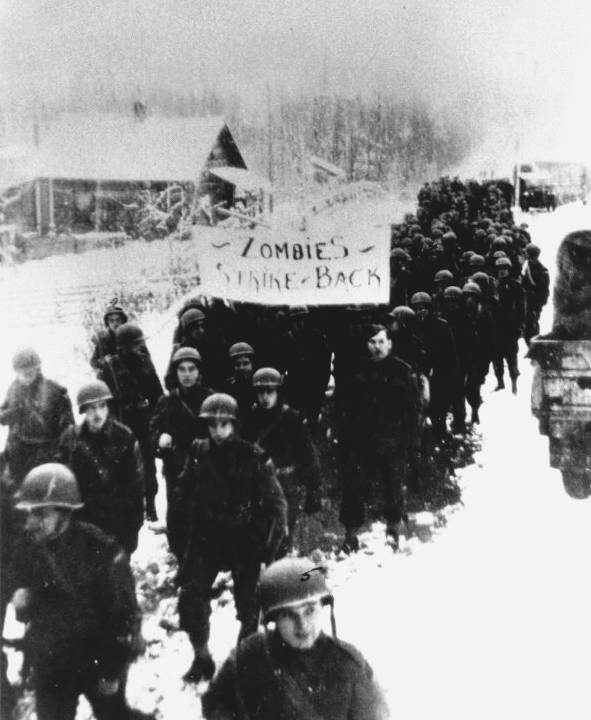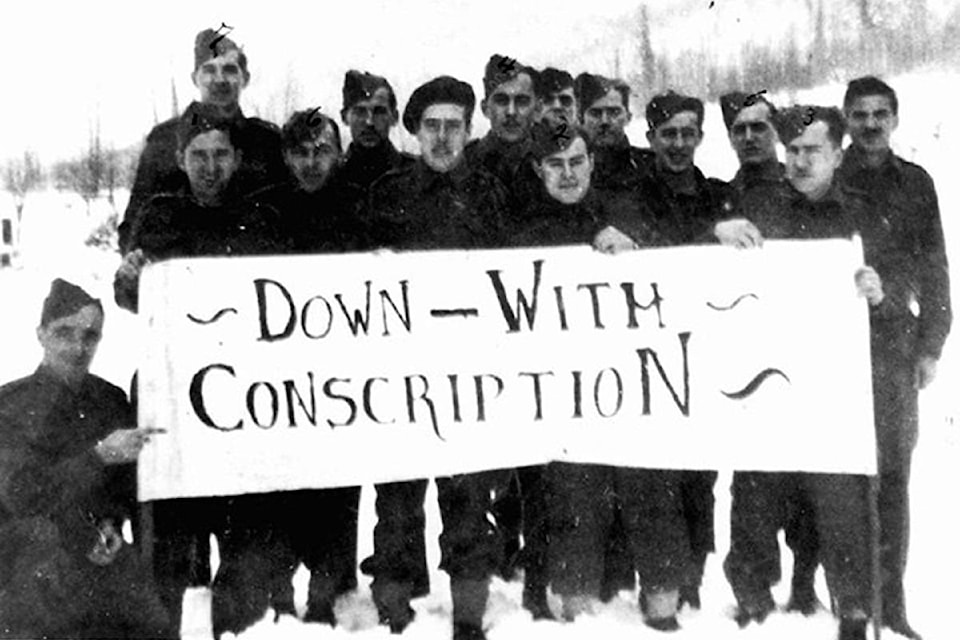In 1944, hundreds and then thousands of soldiers stationed in Terrace during the Second World War, took up arms for five days to protest the Canadian government’s decision to send them overseas.
Although the event from Nov. 24 to Nov. 29, 1944 was the longest lasting mutiny in Canadian history, there was still little known and even less discussed over what happened, Heritage Park Museum curator Kelsey Wiebe says.
“We have so many people tell us that they had no idea that a mutiny had ever happened in Terrace, people who had lived in Terrace all their lives,” Wiebe says.
That led to the Terrace and District Museum Society’s decision to tell the story in the Terrace Mutiny, a book unveiled to city council on Feb. 11. In 2015, the society received a one-time $33,000 grant from the federal government’s World War Commemorations Community Fund to complete the project and create a website (terracemutiny.com) with more information on the book and lesson plans.
“The book will lead to further understanding of the mutiny and Terrace’s place in this very significant episode in Canadian history,” Wiebe says.
READ MORE: Mutiny revived
With a population of fewer than 500 people at the time, Terrace saw 3,000 soldiers from the 15th Canadian Infantry Brigade move in almost overnight during the summer of 1942, putting a strain on the small town’s resources and services.
Two years later on Nov. 25, 1944, the book’s preface reads, more than 1,500 men marched down from their camp on one of the bench areas into Terrace, carrying protest banners and chanting “Down with conscription!”
This was in response to a change made to the 1940 National Resources Mobilization Act (NRMA) that drafted eligible men for home defence only. But by 1942, pressure for conscription to include mandatory service overseas mounted, and efforts by active servicemen to encourage NRMA men to go overseas only inspired discrimination against the ‘zombies’ — the term given to men who were drafted but who had not volunteered to go overseas.
In Terrace and camps across the province, recruitment numbers had been declining, except right after D-Day, with many NRMA men feeling “no real desire or connection to fight a war on European soil for a government they felt abandoned them during the Depression,” the book notes. The remote geographical isolation of Terrace also affected morale.
But on Nov. 23, 1944 the federal government ordered 16,000 men to replenish the Canadian Army, depleted after heavy fighting in Italy and the D-Day landing in Normandy. Growing concern turned to anger over the decision, and soldiers in Terrace decided they would begin an official protest.
While there were other demonstrations in Vernon, Prince George, Courtenay, Chilliwack, Nanaimo and Port Alberni, Terrace was the only place where protests went further to a full-scale mutiny, with mass disobedience to military orders to protesters arming themselves to threats against officers.
READ MORE: Zombies strike back: Canada’s largest military mutiny
The book’s publication was a project 35-years in the making, and started when the District of Terrace (now the City of Terrace) hired summer student Karen Kuechle (Goetz) to do research and write about the mutiny over two summers in 1983 and 1984. This was after the event piqued the interest of a film company in Hollywood. Wiebe says there are still requests from documentary filmmakers about the story.
However, Kuechle’s manuscript was never published and was left in the city’s collection for years until the original copy was given to Wiebe. This was mostly because multiple book and magazine publications declined to publish it, either because of length or lack of interest.
“Everyone said it was not an interesting enough story and it was not historical, and it was too close to the event itself,” Wiebe says of the correspondence.
In 2014, when interviews were conducted for the society’s oral history publication Preserving the Past for the Present: An Oral History Project, Wiebe realized many of the interviews contained stories of the war years and the mutiny, which prompted the museum curator to pursue publication of Kuechle’s manuscript supplemented with new information that had become uncensored since the 1980s.
READ MORE: Heritage Park launches oral history book
“Censorship, a federal government badly wanting to suppress news of the mutiny to avoid more trouble elsewhere and perhaps even a desire that the whole affair should just be forgotten combined to sweep the event under the carpet,” the book reads.
The process wasn’t necessarily straight forward — there was still hostility to the Terrace Mutiny project from some older veterans who were reluctant to talk about the story, which had previously been “shrouded in shame, secrecy and guilt,” Wiebe says.
“We had World War II veterans who had been in the trenches and said when you talk about this story and give this story coverage, you’re glorifying a shameful chapter of our history,” she says. “A lot of times that sense of shamefulness comes from close community connection and wanting to be proud of your community.”
The book contains accounts from witnesses from when the army first arrived in Terrace, when the mutiny began, the federal government’s censorship of coverage of the event, and the point when the mutiny began to wane after the military regained control.
Most ‘zombies’ were then shipped out of Terrace beginning in late 1944, and the military left “almost as quickly as it arrived” in 1945.
When the Secrecy Act ended for the archived material for the mutiny, Goetz, the manuscript’s original writer, was the first person to look at the first wave of documents after they were kept censored for 40 years.
She says Jim Fulton, who was the MP at the time, gathered all the material from Ottawa and sent it to her, revealing an important side of the story that was previously unknown.
“When I got back to the city in the summer [1984] I had boxes of archived material from Ottawa, the court documents word for word, the transcripts, what went on…that was fascinating, and it made a huge difference in the story,” Goetz says.
However, the book notes, it is difficult to prove that any of the soldiers actually served jail time for participating in the mutiny.
“Some of these guys, if not all of them, were put on trains headed back east. I think some of them even jumped off at various points and blind eyes were turned to that,” Goetz says.
“Mutiny is huge, and when your country is just getting out of a war or finishing a war, you don’t need bad press.”
Goetz received a copy of the Terrace Mutiny this week, and says she was “pleasantly surprised” to see it finally published. She now lives in Merritt, B.C. and is a school principal. Over the years she has spoken about the Terrace mutiny to her social studies classes.
“It hasn’t been out of my mind that’s for sure,” Goetz says. “I know some people are going to be disappointed or maybe upset that it went as far as it did, but it’s a moment in Canadian history that’s worth remembering, if not for the lessons that come out of it, but how people and their opinions, who they are and where they come from, matter when we make these big decisions.”
The mutiny left a lasting impact on Terrace, and Wiebe says she agrees that there are still lessons to learn from this chapter of Terrace history.
“It’s interesting always to try and understand how we have dealt with large projects like the military installation, the development of Alcan, and European people settling in the area, and how that has been understood by local people,” she says.
“There’s probably more [information] that still hasn’t been released, but we found quite a bit of material and were able to understand a fuller picture of what happened.”
The Terrace Mutiny will be provided to schools within CMSD82, non-profit organizations and is available for sale at Misty River Books.
brittany@terracestandard.com
Like us on Facebook and follow us on Twitter

